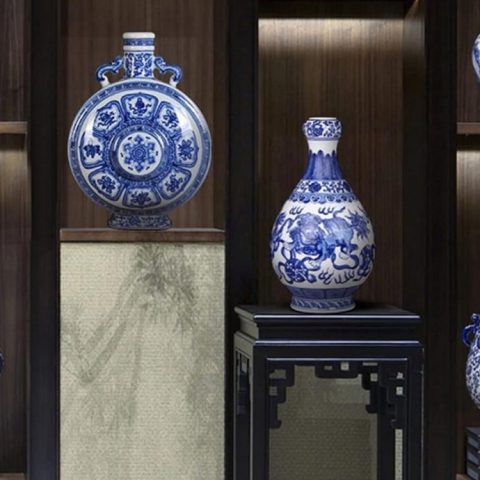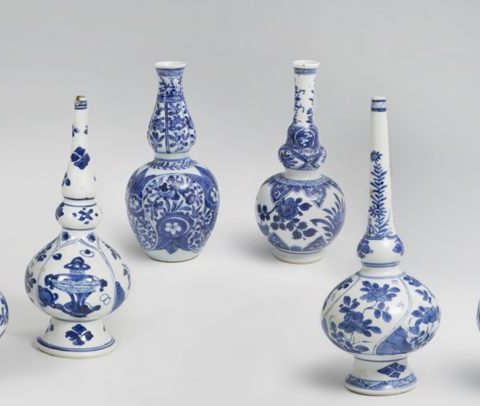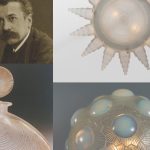Oriental and Decorative Arts Auction
In the province of Hebei, in northern China, during the 7th and 10th centuries, few would have imagined that white pasta cooked at over 1,300 degrees would captivate an entire continent ten centuries later, more than 1,700 kilometers away. But so it was, and this fascinating story of influence and admiration deserves to be told.
At the beginning of the 18th century, in Saxony, Europeans finally unlocked the secret of Chinese porcelain: kaolin. This discovery spread rapidly throughout the continent, leading to the discovery of mines of this precious clay and a proliferation of formulas that sought to perfect the manufacture of hard porcelain, in order to compete with the costly imports from China.
In the 19th century, with European porcelain production already consolidated in the market, industrialization and the decrease in quality in Chinese manufactures, especially in pieces destined for export, provided the perfect context for certain European manufactures to produce imitations of Chinese porcelain at lower cost. This dynamic opened up new opportunities for the European industry and transformed the decorative porcelain landscape.
One of these visionaries was Edmé Samson (1810-1891), a porcelain decorator and bronze artist, initially known as “Samson jeune” around 1849. In 1864, he partnered with his son Emile, and together they participated in the Paris International Exhibitions in 1867 and 1878. At these exhibitions, Samson’s skill at imitation was amply demonstrated, to the point that critics warned collectors about the authenticity of future acquisitions. Driven by success, Emile Samson opened his own factory in Montreuil-sous-Bois, where he exhibited and sold his creations.
From that moment on, the brand did not stop growing, including not only oriental pieces, but also French, Italian, English, German, Hungarian and Hungarian porcelain and earthenware, among others. Inspiration came from the best contemporary private collections, such as those of Frédéric Spitzer, Gustave Dreyfus or Alfred Grandidier, whose works were exhibited at the Louvre between 1894 and 1939 and are now part of the permanent collection of the Musée Guimet. At the end of the 19th century, Edmé’s grandson, Léon, continued the family legacy, expanding production towards partitioned enamels on bronze and developing a new line focused on terracotta sculptures.
However, and due to the expertise with which they made their pieces, which could be mistaken for originals, they were all duly marked, sometimes with stamps or signatures very similar to the originals. It is true that if the customer demanded it, they could dispense with the marking, making them susceptible to cause confusion among collectors. This circumstance, which was not usual, used to occur when a piece of an original set was lost, reproducing it to complete it. There have been cases of museums that purchased these pieces at the time as imitations of older works and that, in later records and inventories, appear as originals, as the purchase documentation has been lost.
Among the Chinese reproductions, those of the Kangxi, Yongzheng and Qianlong periods predominate, sometimes with gilded bronze mounts in the European style. The refined, more sober pieces, popular today, only left China after the sacking of the Summer Palace in 1860 by the French and English, and with the fall of the Manchus in 1911, so they did not constitute a model conducive to reproduction.
In addition, around 1900, amateurs were guided by the advice of great collectors such as the aforementioned Alfred Grandidier, who defended the artistic superiority of polychrome porcelain. Thus, they were looking for large decorative pieces of the “famille verte” or “famille rose”, preferably with gilded bronze mounts.
That said, is it possible to differentiate an original piece from Samson’s fin-de-siecle reproductions?
First of all, it is convenient to compare the pieces with the original models they imitate, but, in general, these models are rigid and rough, showing the western brush, as they lack the Chinese fluidity. On the other hand, the point of view is frontal and not circular, as it should be in the east. As for the paste, it sometimes contains lumps, is pale and too gray, lacking the impurities of iron, although it is not easy to see when it is covered by glazes. If we look at these, the blue below deck is darker, and the glaze has a greenish hue where it has accumulated.
Precisely, in the Guimet Museum itself, among the pieces that were part of the Grandidier collection, it is possible to find vases similar to the one in question, which follow models of the Kangxi period with that striking “bleu soufflé” enamel. Thanks to direct comparison with period models, which may have served Edmé himself and his son, and to the advice given in the previous paragraph, we can conclude that the 35316034 lot did indeed leave the Samson factory. And you, do you agree?

and flowers Qing Dynasty,
Kangxi period.
Guimet Museum

Qing Dynasty floral decoration,
Kangxi period. Guimet Museum

and birds Qing Dynasty,
Kangxi period. Guimet Museum









